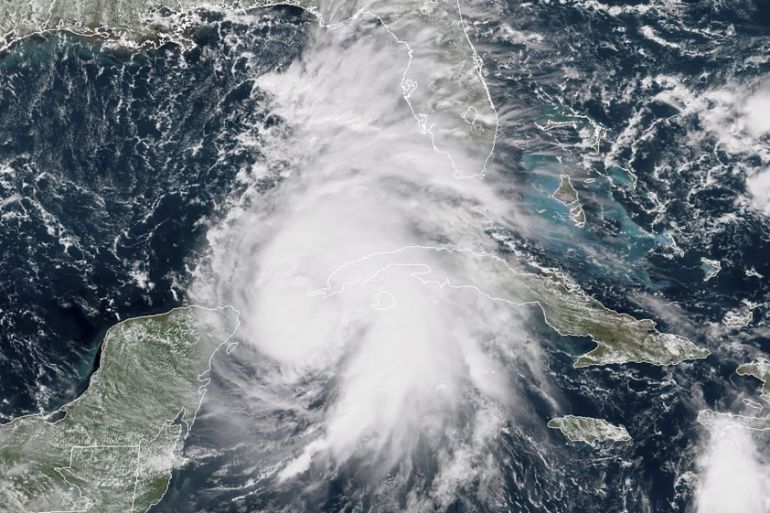Hurricane Michael strengthens to Category 2, heads to Florida
Evacuations under way as ‘monstrous’ storm expected to make landfall on Wednesday, bringing strong wind and heavy rain.

Hurricane Michael swiftly intensified into a Category 2 over warm Gulf of Mexico waters on Tuesday amid fears it would strike Florida on Wednesday as a major hurricane.
Mandatory evacuation orders went into effect Tuesday morning for some 120,000 people in Panama City Beach and across other low-lying parts of the coast as Hurricane Michael approaches.
Keep reading
list of 4 itemsScientists say Oman, UAE deluge ‘most likely’ linked to climate change
Photos: Deadly floods wreak havoc in Kenya’s capital
China evacuates over 100,000 as heavy rain continues to lash south
Residents were boarding up homes and seeking evacuation routes to get out of the way of the storm, which is expected to bring strong winds and flooding rain.
A hurricane hunter plane that bounced into the swirling eye off the western tip of Cuba found wind speeds rising.
By Tuesday morning, top winds had reached 155 kilometres per hour, and it was forecast to strengthen more, with winds topping 179km/h, capable of causing devastating damage.
With the storm entering the eastern part of the Gulf of Mexico, which has warm water and favourable atmospheric conditions, “there is a real possibility that Michael will strengthen to a major hurricane before landfall,” Robbie Berg, a hurricane specialist at the Miami-based storm forecasting hub, wrote in an advisory. Major hurricanes are classified as Category-3 or higher.
13 killed in Central America
Disaster agencies in El Salvador, Honduras and Nicaragua reported 13 deaths as roofs collapsed and residents were carried away by swollen rivers.
Six people died in Honduras, four in Nicaragua and three in El Salvador. Authorities were also searching for a boy swept away by a river in Guatemala.
Most of the rain was blamed on a low-pressure system off the Pacific coast, but Hurricane Michael in the Caribbean could have also contributed.
Forecasters warned that Michael could ultimately dump 30cm of rain in western Cuba, triggering flash floods and mudslides in mountain areas.
For the US, the hurricane is expected to be the most powerful storm to strike Florida’s panhandle in the last decade.
#HurricaneMichael isn't heading to any one town…
There are warnings for more than 300 miles of coastline. It's forecast to be a large and dangerous hurricane at landfall.
✔️Life-threatening storm surge
✔️Damaging winds
✔️Life-threatening flash floodinghttps://t.co/VyWINDk3xP pic.twitter.com/nsHYkBjy2r— National Weather Service (@NWS) October 9, 2018
Florida’s governor Rick Scott called Michael “a monstrous hurricane”, and has declared a state of emergency for 35 Florida counties from the panhandle to Tampa Bay.
He has also activated hundreds of Florida National Guard members and waived tolls to encourage those near the coast to evacuate inland.
“We are running out of time,” Scott said in a post on Twitter. “TODAY is the day to get a plan, because tomorrow could be too late.”
‘Life-threatening winds’
The National Hurricane Center (NHC) warned that the waves and rain could trigger deadly flooding and that residents within the hurricane warning zone should likewise “prepare for life-threatening winds”.
On the Florida Panhandle, Escambia County Sheriff David Morgan bluntly advised residents who choose to ride out the storm that first responders would not be able to reach them during or immediately after Michael smashes into the coast.
“If you decide to stay in your home and a tree falls on your house or the storm surge catches you and you’re now calling for help, there’s no one that can respond to help you,” Morgan said at a news conference.
NHC said the storm could unleash coastal storm surges of up to 3.7m along the Florida Panhandle and dump up to 30cm of rain across Florida, Georgia and South Carolina. Alabama and Tennessee were also bracing for the storm’s impact.
A hurricane WARNING has been issued for portions of the Florida Gulf Coast. Everyone in these areas should prepare for life-threatening winds associated with the core of #Michael. Follow @NHC_Atlantic for the latest on #HurricaneMichael. pic.twitter.com/mhV77ESceV
— National Weather Service (@NWS) October 8, 2018
After striking Florida, Michael is forecast to move up the East Coast on Wednesday and Thursday tearing through North and South Carolina, which are still recovering from Hurricane Florence last month. The Category 1 hurricane left dozens dead in the Carolinas and is estimated to have caused billions of dollars in damage.
Last year parts of the US saw a string of catastrophic storms – including Hurricanes Harvey, Irma and Maria. Harvey caused a record-equalling $125bn in damage when it flooded the Houston metropolitan area and other parts of Texas.
Scientists have long warned that global warming will make hurricanes more destructive, and some say the evidence for this may already be visible.
At their most fearsome, these low-pressure weather fronts pack more power than the energy released by the atomic bomb that levelled Hiroshima.